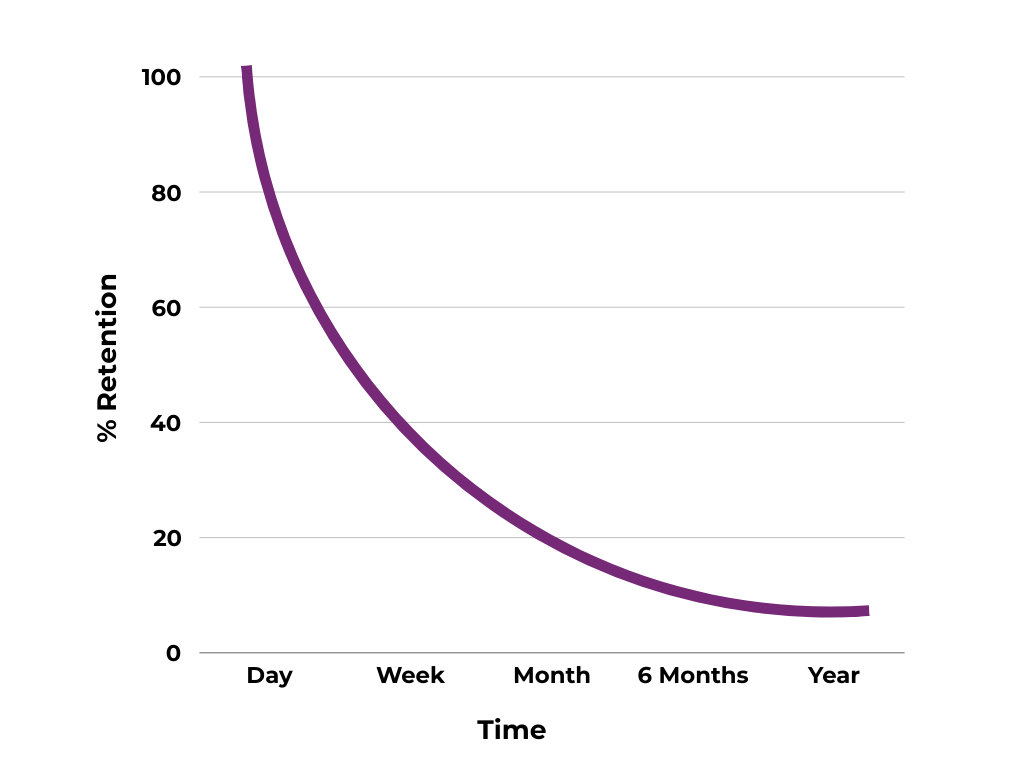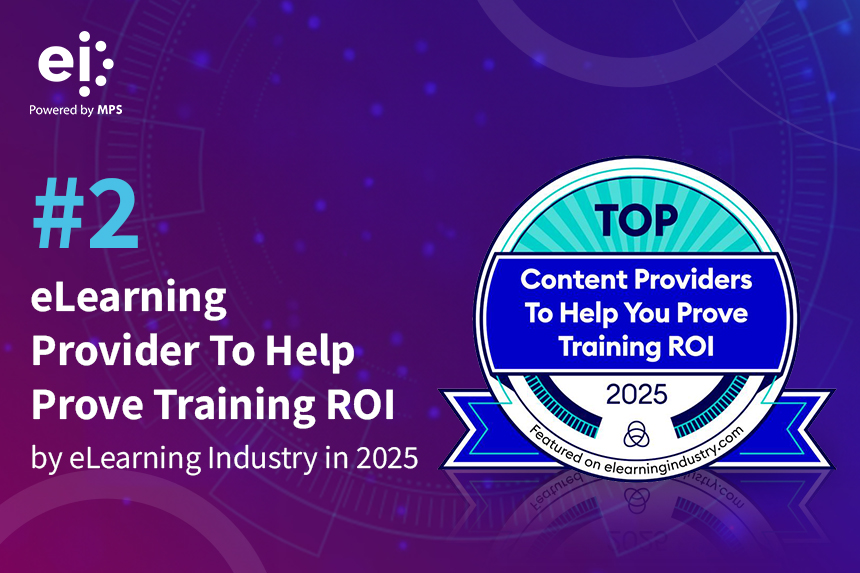
People tend to forget the vast majority of what they learn – especially when new information and skills aren’t immediately applied. In this article, I discuss how microlearning can diminish the Forgetting Curve.
Why Do Employees Forget What They Learn in Training?
Employees frequently fail to retain training information owing to a lack of practice and an overwhelming amount of information offered, which may not necessarily be relevant to their tasks. Without opportunities to actively engage with and practice the subject, recall diminishes rapidly, especially as time passes and new information clashes with previously taught notions.
What Is the Forgetting Curve?
The term ‘Forgetting Curve’ was coined by Hermann Ebbinghaus in the 1880s and allows for an understanding of the rate of loss of information over time in the absence of reinforcement. It was later established by Ebbinghaus that within one hour of learning something new, people tend to forget approximately 50% of what they just learnt, and this could even reach 70% when a person is up to 24 hours away from the session. A week later, people forget approximately 75% of what they have learned.
This decline stresses the limited reserve of information storage and the importance of systematic revision and spaced learning required to combat memory decay. The Forgetting Curve increases not only the effectiveness of an individual learner but is also of utmost importance for the structure of learning and training methods used in organizations.
The History of Ebbinghaus’s Forgetting Curve
Hermann Ebbinghaus (1850-1909) is well recognized as one of the first researchers to explore memory as a phenomenon and establish its scientific foundation. This study, conducted in the latter part of the 19th century, was devoted to the mechanics of forgetting, resulting in the “Ebbinghaus Forgetting Curve.” Among them became parameters of memory retention even in the form of nonsense syllables.
Here is an illustration of Ebbinghaus’ Forgetting Curve, where within the first 2 weeks a lot of information is probably lost and then the curve tends to plateau. Interestingly enough, TalentCards once surveyed 600 people who were frontline workers and as it turned out, people do not realize how fast they forget things. Many of them think that even after a month, over 50% of what was trained is retained; but the reality is that people without reinforcement cannot retain even 20% of what was taught.

According to Ebbinghaus’ researches, the most critical factors helping overcome such a quick decrease are using learning techniques that include spaced repetition and active recall. These published works, notwithstanding their small number, radically changed the comprehension of memory from a subject of philosophical contemplation to that of scientific investigation, thus setting the stage for further developments in cognitive psychology and pedagogy. Ebbinghaus’ insights remain a cornerstone in understanding how we learn and retain information, highlighting the need for regular reinforcement to counteract memory decay.
Factors That Affect Learning Retention
- Memory strength: Effective learning relies on relevant and engaging content, as stronger memories are retained for longer periods of time.
- Relevance of learning: Material that connects to learners’ experiences and interests enhances retention by reinforcing the significance of the information.
- Time that has passed since the learning event occurred: The greatest amount of forgetting occurs within the first hour after learning, emphasizing the need for timely reinforcement.
- How the learning material is presented: Interactive and well-structured learning experiences, including varied training methods, promote longer retention and reduce forgetfulness.
- Feeling and other physiological factors: Emotional engagement and adequate rest, such as sleep after learning, strengthen memory and enhance the ability to recall information later.
What Are the Implications of the Forgetting Curve?
Learners are bombarded with large amounts of information. Corporate training teams are faced with the reality that employers need employees on the job as quickly as possible. Unfortunately, this often triggers the Forgetting Curve.
Time-consuming training programs create diminishing returns on investment. Because of the steep Forgetting Curve, employees are less efficient, and they’re forced to invent answers for problems on their own or become dependent on SMEs.
This may also have legal or safety ramifications. Within many industries, employees are required to adhere to compliance regulations. If those regulations or laws are transgressed, employees may be subjecting themselves and their company to lengthy and expensive court proceedings.
How Do You Overcome and Offset the Forgetting Curve in Your Learning Programs?
Corporations can overcome the Forgetting Curve by fostering a healthy learning and performance ecosystem, rich with microlearning options.
The following instructional principles should make up the foundation of a sound learning and performance ecosystem.
- Activate prior knowledge to create a strong foundation on which new knowledge can be constructed.
- Establish a shared knowledge foundation with learning solutions on which new behaviors can be constructed. Employee training programs, either formal or informal (employing microlearning tactics), will have a starting point from which to launch successive efforts.
- Use the scaffolding technique of guided instruction, practice, assessment, and remediation to help overcome the Forgetting Curve. Also, minimize cognitive load by excluding extraneous information.
- Employ the learn, apply, and feedback loop to reduce the impact of the Forgetting Curve. As employees learn, they should have the opportunity to immediately apply what they’ve learned and receive feedback from coaches.
- Leverage informal learning and microlearning outside formal employee learning programs. Healthy learning and performance ecosystems support and encourage informal learning as employees self-direct and curate content.
- Leverage the power of spaced learning to reinforce information over time, improving memory retention and reducing the Forgetting Curve.
- Make training materials easily accessible and on-demand, allowing employees to learn and apply skills in real-time settings.
- To sustain engagement, use various presentation methods including videos, quizzes, and hands-on activities that cater to diverse learning styles and motivate learners.
- To improve retention, schedule regular follow-up sessions and refreshers to reinforce knowledge and practice skills.
- Ensure training is relevant and practical to employees’ jobs and challenges, increasing the possibility of knowledge application in the workplace.
- To improve retention, break down extensive courses into microlearning modules. This allows learners to absorb knowledge in compact, manageable nuggets, making crucial topics simpler to remember over time.
What Microlearning Approaches Can Be Used to Offset the Forgetting Curve?
Microlearning can be leveraged very effectively to offset the Forgetting Curve as shown here:
- Use quick microlearning hits to review what was covered more formally in employee learning programs and refresh prior knowledge.
- As old processes are updated, use pointed, formulaic, and short microlearning text or video objects to inform employees.
- Blend formal employee learning programs with interspersed microlearning objects, building layers of instructor-led sessions, practice, and microlearning objects to which employees can turn to for reference.
- Self-directed learning is often more powerful than traditional employee learning programs when counteracting the Forgetting Curve. Provide an environment where employees can seek new information, curating the content they find in a way that’s shareable with coworkers.
- Spaced learning is an effective method of overcoming the Forgetting Curve. At consistent intervals, provide additional microlearning with practice opportunities in employee learning programs. This will help reinforce what employees have learned, solidifying their ability to recall information when they need it.
- Integrate learning into everyday tasks to enhance efficiency and reinforce abilities in real-time.
- Use microlearning to improve employee performance by providing brief resources such as job aids or quick videos that can be conveniently accessed while on the job. This helps employees retain important information when needed.
How Do You Use Microlearning to Reinforce Learning and Improve Learning Retention?
Finally, use these examples of microlearning to reinforce learning and eliminate the Forgetting Curve:
- Short videos can be an engaging way to provide new information or review information that was covered in formal employee learning programs.
- Infographics are informative at a glance and can refresh important information such as product knowledge or process workflows.
- Animated and explainer videos quickly engage learners, pulling them into quick learning opportunities.
- Messages from leadership in print, video, and even audio format can formalize new processes, helping employees quickly understand the big picture behind any new process or policy.
- Short scenarios can be used for practice and for the application of the acquired learning. The feedback can be leveraged to reinforce the primary learning.
- Encourage expert video tips wherein SMEs can break complicated processes down into small, consumable chunks that employees can watch when they need.
Acknowledging the Forgetting Curve creates a space to blend microlearning to create a strong and effective learning and performance ecosystem for employee learning programs. I hope my article provides the insights you can use to offset the Forgetting Curve through microlearning and create a Retention Curve.



